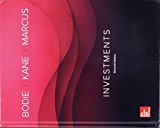
Concept explainers
A.
To calculate: The modified duration of the bond, based on the given information.
Introduction: Using modified duration, we can measure the sensitivity involved in the
B.
To Determine: The reasons supporting the measure of modified duration being better than the maturity in finding out the sensitivity of a bond with respect to the changes in interest rates.
Introduction: Using modified duration, we can measure the sensitivity involved in the bond price with respect to the changes in the yield to maturity of the bond.
C.
To Determine: Comment on the changes in modified duration and maturity, with respect to the given information.
Introduction: Using modified duration, we can measure the sensitivity involved in the bond price with respect to the changes in the yield to maturity of the bond.
D.
To Determine: The convexity and what is the use of it and modified duration in determining the percentage change in price of the bond, with respect to the changes in its interest rates.
Introduction: Convexity helps in expressing the changes in the duration of the bond, with respect to the changes in the interest rates.
Using modified duration, we can measure the sensitivity involved in the bond price with respect to the changes in the yield to maturity of the bond.
Want to see the full answer?
Check out a sample textbook solution
Chapter 16 Solutions
Investments, 11th Edition (exclude Access Card)
 Intermediate Financial Management (MindTap Course...FinanceISBN:9781337395083Author:Eugene F. Brigham, Phillip R. DavesPublisher:Cengage Learning
Intermediate Financial Management (MindTap Course...FinanceISBN:9781337395083Author:Eugene F. Brigham, Phillip R. DavesPublisher:Cengage Learning
 EBK CONTEMPORARY FINANCIAL MANAGEMENTFinanceISBN:9781337514835Author:MOYERPublisher:CENGAGE LEARNING - CONSIGNMENT
EBK CONTEMPORARY FINANCIAL MANAGEMENTFinanceISBN:9781337514835Author:MOYERPublisher:CENGAGE LEARNING - CONSIGNMENT


